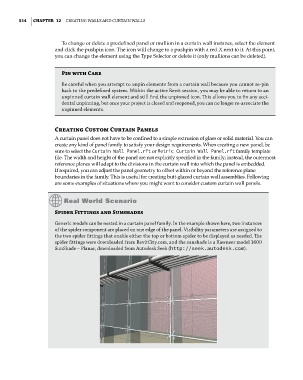Page 548 - Divyank Tyagi
P. 548
514 | ChaPTER 12 Creating Walls and Curtain Walls
To change or delete a predefined panel or mullion in a curtain wall instance, select the element
and click the pushpin icon. The icon will change to a pushpin with a red X next to it. At this point,
you can change the element using the Type Selector or delete it (only mullions can be deleted).
Pin with Care
Be careful when you attempt to unpin elements from a curtain wall because you cannot re-pin
back to the predefined system. Within the active revit session, you may be able to return to an
unpinned curtain wall element and still find the unpinned icon. This allows you to fix any acci-
dental unpinning, but once your project is closed and reopened, you can no longer re-associate the
unpinned elements.
Creating Custom Curtain Panels
A curtain panel does not have to be confined to a simple extrusion of glass or solid material. You can
create any kind of panel family to satisfy your design requirements. When creating a new panel, be
sure to select the Curtain Wall Panel.rft or Metric Curtain Wall Panel.rft family template
file. The width and height of the panel are not explicitly specified in the family; instead, the outermost
reference planes will adapt to the divisions in the curtain wall into which the panel is embedded.
If required, you can adjust the panel geometry to offset within or beyond the reference plane
boundaries in the family. This is useful for creating butt-glazed curtain wall assemblies. Following
are some examples of situations where you might want to consider custom curtain wall panels.
Spider Fittings and Sunshades
generic models can be nested in a curtain panel family. in the example shown here, two instances
of the spider component are placed on one edge of the panel. Visibility parameters are assigned to
the two spider fittings that enable either the top or bottom spider to be displayed as needed. The
spider fittings were downloaded from revitCity.com, and the sunshade is a kawneer model 1600
sunshade – Planar, downloaded from autodesk seek (http://seek.autodesk.com).
c12.indd 514 5/3/2014 11:13:18 AM

